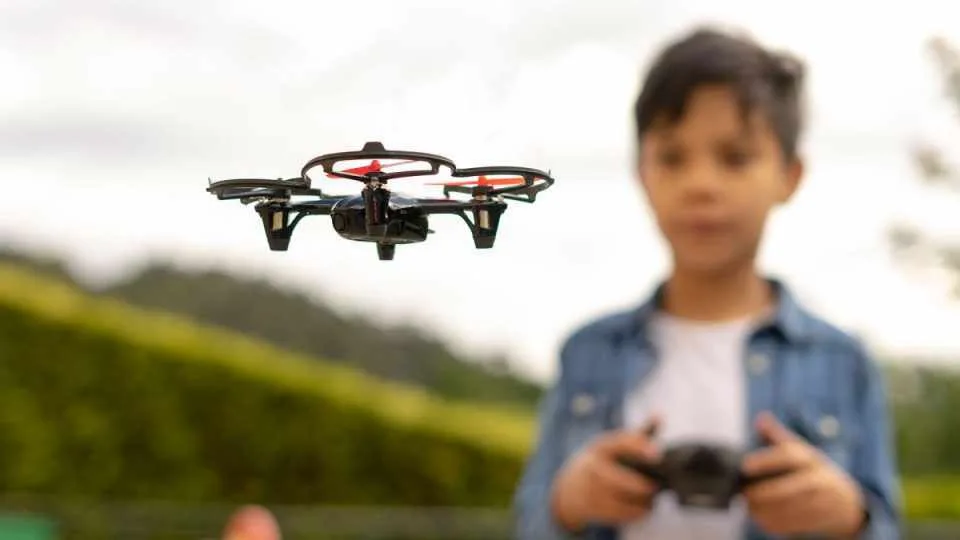With robots, drones, AI and automation set to dominate industry in the coming decades, the drone sector has been earmarked as a burgeoning employment pathway for future generations.
Currently, the economic impact of drones contributes an estimated $5.5 billion to the Australian economy which will rise to $14.5 billion by 2040, according to a government study published by Deloitte.
“There’s a huge potential for Australia’s drone industry because in many ways we are already leading in drone regulation and usage,” says Australia’s most learned drone expert, Dr Catherine Ball from Australian National University.
“Australia is the only place in the world where you can get a license to operate, a commercial drone delivery service. Everywhere else, you have to get an exemption from the regulations, and generally you are restricted to trials on military bases.”
Dr Ball says one of the keys to the Australian drone industry growing, innovating and becoming a world leader is to get kids at both primary and high school level more interested in the fun of STEM and to understand and how drones can impact the world at a societal level.
“We need to attract more kids to STEM pathways once they leave school,” says Dr Ball. “They need to see how enjoyable and rewarding it can be working in the industry. Medicine will always be popular for bright minds, but at ANU the existing engineering degree has been losing students. I’m now part of a new project there called Reimagine where we humanise the subject more in order to broaden its appeal.”
Several drone companies now offer high-school level drone classes and kids learn to code company, Code Camp, recently introduced Drone Camp for those aged 9-13. At the in person three-day summer holiday camps held at schools, kids will learn how to fly and code a drone. Developed by drone enthusiasts, the hands-on technology program is powered by US-based Drone Legends.
“Drones are here to stay – and there are a number of compelling reasons to teach kids how to use them,” says Code Camp co-founder Hayley Markham. “Safety is essential, but we see when a kid launch their first drone, there’s a real mix of excitement, confidence and wonder in the air. When they code their flight path and see their drone take to the sky, it teaches them teamwork, problem solving, dexterity and also builds their confidence for solo missions.”
Markham’s co-Founder Ben Levi adds that drones are integral to the future of technology. “The scope of using drones within our daily lives is growing exponentially, with more and more people getting into the drone industry and achieving incredible things. We really want all kids to develop an early love of tech so the brightest minds continue on in the industry when they’re older.”
Already drones are being used throughout Australia and the world in a number of projects. Dr Ball, who runs the annual World Congress of Drones and Robots, predicts the 2032 Olympics in Brisbane will be the most environmentally friendly and automated Olympics we have ever had.
“Drones will be involved in everything at the Olympics from transport networks, to how food will be delivered in stands. There will also be AI involved in ticketing and public health measures.”
Other current drone projects around Australia include the following:
Shark monitoring
Ripper Corp based in NSW, have partnered with Advanced Navigation in a world first to simultaneously fly multiple drones along a 1000 km stretch of Australia’s coastline from QLD to NSW this summer. The venture has resulted in the development of Cloud Ground Control, a revolutionary cloud platform that can control up to 1,000 drones from a web browser over 4G/5G networks.
Delivering medical supplies to remote Indigenous communities
Brisbane drone business Hover UAV is part of an upcoming project in conjunction with IMove and NT Health where customised drones to deliver medical supplies to remote Indigenous communities in the Northern Territory. Test flying will begin in the next few months. A lot of these communities are currently blocked off by water in the rainy season. At the moment supplies are being delivered by plane, but this is expensive. It’s said that up to 50 per cent of the supplies are sometimes not viable as they have been left on the side of runways and spoil.
Reforestation
Global Drone Solutions in Perth is also involved in reforestation and recently planted over 1,000 trees with their drones in four hours near the town of Dowerin, 300km east of Perth. The reforestation was part of the Auria Arid Region Forestry Research Project established in 2001 concerning 440 acres of highly degraded land in a low rainfall region of Western Australia. In 2008 the project was enlarged to 600 acres and around 1 million trees have now been planted.
Delivering vaccines across Africa
During the COVID-19 pandemic, Melbourne’s Swoop Aero’s Malawi network achieved a feat that no other company in the industry has been able to do successfully – sustain a bi-directional medical drone logistics network from another country. Swoop Aero is also one of the first companies globally to transport the recently approved WHO malaria vaccine in the Southern districts of Nsanje and Chikwawa to achieve increased immunisation coverage in hard-to-reach and isolated areas.
Monitoring koala populations
The University of Newcastle’s School of Environmental and Life Sciences has been developing a drone program to monitor koala populations in the wild, mainly in the mid coast region of NSW. Flying their thermal drone at night in forests, the university team found an average of one koala every two hours. By foot it takes around seven hours to spot a koala. Koala populations were impacted significantly by the bushfires. In future fire seasons, the method may also be useful for wildlife rescue localised population monitoring, pre-land use surveys such as before development, logging or hazard reduction burning, and after rehabilitation to check on released koalas.







